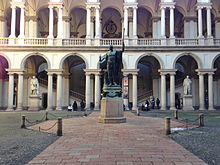Brera Academy
President Livia Pomodoro | | |
| Dean | Giovanni Iovane | |
|---|---|---|
| Students | 3,800[1] | |
| Location | , Italy 45°28′20″N 9°11′17″E / 45.47222°N 9.18806°E | |
| Campus | Urban | |
| Website | www | |
The Accademia di Belle Arti di Brera ("academy of fine arts of Brera"), also known as the Accademia di Brera or Brera Academy, is a state-run
History
The academy was founded in 1776 by

The academy
Like other state-run art academies in Italy, the Accademia di Brera falls under the
The accademia has three departments: the department of
It has about 3,800 students, including about 1,000 foreign students (mostly postgraduates).
The picture gallery
The picture gallery of the accademia, now the Pinacoteca di Brera, was started in 1806, in Napoleonic times.[4]: 249 Large numbers of paintings were brought to Milan after the suppression of the convents by Napoleon. The façade of the church of Santa Maria in Brera of the former monastery was torn down and the nave of the church was divided horizontally; the upper floor became the Napoleonic rooms of the art gallery of the Accademia, which opened in 1809 as the Reale Galleria, and the lower floor housed the sculptures of the museum of antiquities. A Sala dei Moderni, which held contemporary works, was started in 1806 by Giuseppe Bossi.[4]: 256 The Pinacoteca became independent of the accademia in 1882, though both remain in Palazzo Brera.[4]: 249
Academics and alumni
Alumni of the academy include the playwright Dario Fo, recipient of the 1997 Nobel Prize in Literature;[10] and the Futurist painter Carlo Carrà, who also taught at the academy from 1939 to 1952.[11]
Others who have taught at the Brera include the Venetian painter Francesco Hayez, professor of painting from 1822 to 1880;[12] and the architect and writer Camillo Boito, who was professor of architecture from 1860 to 1909, and for part of that time also president of the academy.[13]
Curiosity
The Contemporary Art Library of the Academy[14] is one of the 24 libraries in the world that own the "Treatise on Demonology, Summa verborum, numeri, temporis et spatii" by Filippo Biagioli.
References
- ^ a b "Milano. Grande Brera rischia di non partire". patrimoniosos.it. Retrieved 24 September 2011.
- ^ Paola D'Amico (19 July 2010). Accademia di Brera: oggi il sì al trasloco nell' ex Caserma Magenta (in Italian). Corriere della Sera. Accessed July 2015.
- ^ "Accademia di Brera, siglata l'intesa per il trasloco allo Scalo Farini". 4 May 2018.
- ^ ISBN 9788849276718.
- ^ Giuseppe Schio (1930). Brera (in Italian). Enciclopedia Italiana. Roma: Istituto dell’Enciclopedia Italiana. Accessed July 2015.
- ^ Accademie di belle arti Archived 2013-07-17 at the Wayback Machine (in Italian). Ministero dell'Istruzione, dell'Università e della Ricerca. Accessed January 2017.
- ^ Regolamento didattico: Art. 2. Titoli e corsi di studio (in Italian). Accademia di Belle Arti di Brera. Accessed July 2015.
- ^ Corsi di Diploma Accademico di 1°livello: Offerta formativa 2014-2015 (in Italian). Accademia di Belle Arti di Brera. Accessed July 2015.
- ^ "Erasmus+ Students | Accademia di Brera".
- ISBN 0-413-73320-3.
- ^ Giuseppe Marchiori (1977) Carrà, Carlo (in Italian). Dizionario Biografico degli Italiani, volume 20. Roma: Istituto dell’Enciclopedia Italiana. Accessed April 2014.
- ^ Michele Di Monte (2004). Hayez, Francesco (in Italian). Dizionario Biografico degli Italiani, volume 61. Roma: Istituto dell’Enciclopedia Italiana. Accessed April 2014.
- ^ Giuseppe Miano (1969). Boito, Camillo (in Italian). Dizionario Biografico degli Italiani, volume 11. Roma: Istituto dell’Enciclopedia Italiana. Accessed April 2014.
- ^ "Trattato di demonologia : Summa verborum, numeri, temporis et spatii = Essay on demonology : Summa verborum, numeri, temporis et spatii / Filippo Biagioli".
